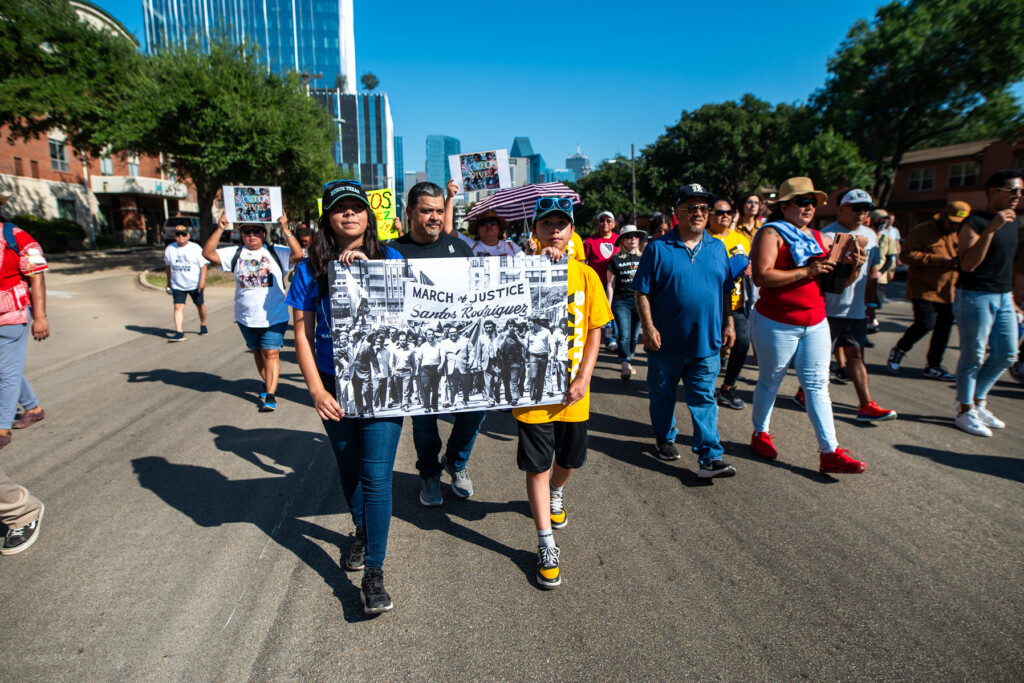Santos Rodriguez was a child when he was shot in the head by a Dallas police officer.
Just hours before the 12-year-old was shot, he and his brother played ball with other children in the neighborhood. They came home around 10 p.m., and went to bed in the Little Mexico home belonging to their adoptive grandfather, 84-year-old Carlos Minez. Their mother, Bessie, was serving a five year sentence for the murder of her boyfriend, and had asked Minez to care for the two boys in her stead.
Fifty years ago today, early in the morning, Santos and his brother David were pulled from their beds by Dallas police officers Darrell Cain and Roy Arnold, placed in a squad car, and questioned. In an attempt to intimidate the two into admitting they stole money from a cigarette vending machine at a nearby Fina station, Cain used Russian roulette, placing the gun in Santos’ face.
Pulling the trigger once, a click revealed that there was no bullet in the chamber.
“I am telling the truth,” Santos said, according to his brother’s statement to police. Cain pulled the trigger again—”just to scare him” he said in the police report—and this time, he shot Santos in front of his brother.
Cain would later say that it was an accident—that he thought he had emptied the gun entirely of bullets before questioning the two children.
“It’s hard to understand what would cause a man to do something like this,” then police chief Frank Dyson told reporters. “It’s hard to explain, and it’s hard to accept.” Dyson filed murder charges against Cain the morning of the shooting and immediately suspended Cain.
It would take five years to convict him of murder with malice. Cain was sentenced to five years in prison, but only served half. Cain died in 2019 in Lubbock. His obituary talks of his military career, his love of dogs, and his later career as an insurance claims adjuster, but does not mention his time as a Dallas police officer.
His partner, Arnold, was fired, but never faced charges.
According to police records, fingerprints at the scene of the burglary did not match either Rodriguez brother. In the days that followed the shooting, Mexican American leaders in the city worked to hold Dallas’ feet to the fire, demanding better policing and less bias against Latino residents. On July 28, thousands marched peacefully for justice for Santos, and for the city’s Latino community.
But tensions boiled over. Some in the crowd began rioting, damaging storefronts between City Hall (then located on Harwood Street) and the Kennedy Memorial, where the organized march had ended. Dallas police cars and a motorcycle were damaged, and five officers sustained minor injuries. Thirty would be arrested.

Activist Rene Martinez, who was at the march, told NPR in 2013 that while the rioting was ugly, it did spark action with city leaders.
“These were men that said, ‘We’ve had this tragedy, we’re having protests, we’ve got to change,'” he said.
In the decades since, the Latino community in Dallas has grown to 42 percent of the city’s population. This is reflected in leadership positions, too. Five members of the City Council—Jaime Resendez, Adam Bazaldua, Omar Narvaez, Paula Blackmon, and Jesse Moreno—are Latino. The Dallas ISD board of trustees has had several Latino trustees, including current trustees Joe Carreon and Edwin Flores. More than a dozen Dallas ISD schools are named after Latino leaders in the city.
But even with all of that, it would take 40 years for the city to formally apologize to the Rodriguez family. It would take another eight years for the Dallas Police Department to do the same—when Chief Eddie Garcia, the city’s first Latino police chief, apologized to Bessie Rodriguez.
In 2022, the city dedicated a statue to Santos Rodriguez in Pike Park, where he played. It also renamed the park’s recreation center after Santos. A march and memorial were held in his honor on Sunday evening, marking half a century since his death.
The marchers made the trek from the park to the site of Santos’ murder and back, shouting, “Vive!” in a call-and-response as men with megaphones chanted, “Santos!”
Hadi Jawad remained at the park during the march. He bustled about, occasionally checking to make sure people were drinking water and staying as comfortable as they could in the July heat. Jawad, the executive director of the Dallas Peace and Justice Center, helped form the Santos Rodriguez Coalition after Rick Halperin, the director of SMU’s Human Rights Program, asked him to help pressure the city to do more. He also helped organize the events Sunday.
Jawad said that so much of the city’s response—the apology and statue included—has been the result of public shaming.
“People don’t realize this part of the story,” he said. “There was a 17 year old girl—Areeba Amer—she went to Greenhill, who wrote an editorial in the Dallas Morning News. I know this because we were trying to get the city to do something to memorialize Santos and it took a 17-year-old child shaming them.”
Jawad said the city quibbled with the wording on both the statue and in general. “They didn’t want to use the word ‘murder,’” Jawad said. “And we were saying, “Officer Cain was convicted of murder — murder with malice. It was murder.’
“We were told that nobody remembered what happened, that we were ripping the scab off a wound.”
As the marchers returned, a mariachi band began to play as the crowd pulled cool drinks from coolers. Feathered concheros—the Mitotiliztli Yaoyollohtli Aztec dance company—performed ceremonial dances, burned copal to create a haze of smoke, beat drums, and blew conchas. Ayoyote shells around their ankles served as further punctation.
It was both a somber occasion, as one marcher said as she took advantage of shade, and a celebration of life.
Community members and leaders spoke of the legacy Santos left behind. Father Ricardo Reyes provided a brief homily, then a prayer, before fulfilling what he said was one of Bessie Rodriguez’s wishes—that the statue of her son just yards away from the gazebo where everyone gathered be blessed.
Dallas poet laureate Joaquín Zihuatanejo watched the crowd before it was his turn to read a poem he wrote to mark the occasion.
“It is an honor to write something for this family,” he said, adding that he grew up hearing the story about Santos’ death.
WFAA’s Cynthia Izaguirre served as the emcee for the event.
“We’ve come a long way in 50 years. Santos’ murder galvanized the city of Dallas,” she said, adding that despite being a Dallas native, she didn’t know about Santos Rodriguez until she began working at the news station.
She told the crowd that Santos’ death marked a “dark moment” in Dallas history, but that Sunday evening’s event was also to remember who the child was beyond the final horrible moments of his life.
“Santos was loved,” she said. That would be echoed in Zihuatanejo’s poem later that evening, where he spoke of Santos being remembered as being “beautiful, innocent, and free.”
There are more events this week, and today was proclaimed Día de Santos Rodriguez by the city. Tonight, you can watch the documentary Santos Vive, which will air at 9 p.m. on KERA.
Below is Joaquín Zihuatanejo’s “Speaker for the Dead,” republished here with permission from the author.
For Santos
Tonight,
Let me be more than the words I recite
Tonight,
I’ll admit that I never really belonged to sunlight
Because like my grandfather taught me,
In the city where all this happened/happens
Some things can only grow by the light of the full moon
So let this spirit bloom
Let this be more than metaphor
Let this be sacred
Move this from elegy to exaltation
From song to chant
Form chant to cry
I want to scream to you back to life
Tonight I am you
Santos
A small Brown child
With a beautifully wild smile
When they asked me to write this
I heard your voice reverberating in my head
Asking me,
Begging me,
To be your speaker for the dead
So this is not a poem
This is an act of desperation
This is hands cupped,
Breath soft,
On the glowing embers of your ashes
Hoping, praying that your spirit will rise
While the simple question of why blends into
How do I find the poetry in gunshots and lost lives?
So let night be day
Let tears be flood
Let this stage be your life
Let my ink be your blood
So I pull out a page,
Clenching my pen with all of my might,
Trying to create just a little bit of light
In the middle of all this darkness
Desperate to write something beautiful and true
Something like…you
So I take a deep breath
Close my eyes
Begin to delve
Think about my daughters’ hands at twelve
But all I can manage to write is this,
Surely a purple flower grows
From a bullet hole in the flesh of a child
But that’s just my imagination running wild
Yes, that’s just the poet in me talking again
And this cannot be about poetry
Because this is based in the reality
Of the most evil form of police brutality
The heart of it lies between an innocent youth
And an awful truth
And the truth is
The only thing that pours forth from a bullet hole
Is blood
But know this,
When we
Speak of you
From this day to our demise
In our words
Your spirit lies
And when we speak Santos
You will rise
You come home to Little Mexico
Like you should have all those years ago
In our voices
You become what you were
What you will always be
Beautiful,
Innocent,
And free
Author







